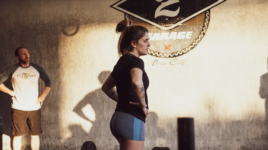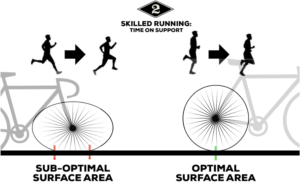
We’ve been taking a much needed look at the mechanics of running and specifically how to align runners more closely with nature. In Part 1, we set the table with why the poor feedback loop of running, lack of a standard, and a strong quantitative (rather than qualitative) orientation of the running community has resulted in a situation where almost no one runs well and most runners get injured doing an activity they think is safe.
In Part 2, we unlocked the unlimited power supply for running: gravity. Using gravity means we can run further, faster, safer with less muscular effort. Running is an act of falling.
This installment builds on the previous concept. I’ve observed the following movement experiment for 15 years and I invite you to try it. Freeze yourself in a running pose, one foot on the ground, the other foot up with your arms in a running posture. When you’re ready, pull your planted foot from the ground as quickly as humanly possible.
Never and I mean never have I seen someone fall to their knees not having a foot to stand on. Of course, instead, you naturally posted your other foot on the ground. Why is this anything other than silly and redundant? Hear me out.
Coaches know that the best cues are the ones where an athlete can do something. It’s less effective for an athlete to try to avoid an action. “Don’t bend your knees,” for example, doesn’t communicate a desired result as well as “squeeze your quad muscles” does and both accomplish the same action with different messages. My cue to you to improve your running is to focus your running attention on pulling your foot from the floor.
Notice where you put your foot down. This is another reason why the drill is important. Try the experiment again if needed. You placed your foot directly under your hips. This solves all of the drama and issues in the running community surrounding where and how the foot should strike the ground (ironically without a mention or focus on it). It’s impossible and unnatural to strike out in front of your hips or on your heel. You’d fall down. Both of which are common running faults.
 Before we wrap up Part 3 of this conversation there are even more reasons that running should be a pulling exercise not an act of pushing off. “Time on support” is the time from when a foot hits the ground (ideally under the hip) until it comes off the ground for the leg cycle. Injuries happen on the ground (not in flight). Generally speaking, you’d improve your running results and safety with less time on support. Pulling the feet from the floor decreases time on support and, as we saw in our silly experiment, when you pull the foot from the floor the other foot must come down.
Before we wrap up Part 3 of this conversation there are even more reasons that running should be a pulling exercise not an act of pushing off. “Time on support” is the time from when a foot hits the ground (ideally under the hip) until it comes off the ground for the leg cycle. Injuries happen on the ground (not in flight). Generally speaking, you’d improve your running results and safety with less time on support. Pulling the feet from the floor decreases time on support and, as we saw in our silly experiment, when you pull the foot from the floor the other foot must come down.
There’s no use in focusing on an action, like where to strike the ground, if you can do perfectly without thinking about it. Rather, your focus should be pulling your posted foot from the ground.
Getting your foot off the ground shortens both the front foot contact point and the time spent on the ground during the recovery. Similar to how a properly inflated bike tire rides faster and more efficiently than a flat bike tire does with all its surface area contact, we want to be more surgical in how much time our feet spend supporting our bodyweight while running.
Pulling the foot from the floor keeps your “tires full” for faster, more efficient running. Stay tuned for our finale, Part 4, where we roll out the standard for running as presented by Dr. Romanov for the nail in the coffin on the argument that we can run in congruence with nature.
Happy running, everyone!
Logan Gelbrich
@functionalcoach
3/31/20 WOD
Progressive Stability Work:
Complete 4 rounds for quality of:
:12 Left-Side Captain Morgan (Right Knee Up + Toe Up)
:12 Left-Side Captain Morgan (Left Knee Up + Toe Up)
:15 Crow Position Hold
:12 Right-Side Captain Morgan (Right Knee Up + Toe Up)
:12 Right-Side Captain Morgan (Left Knee Up + Toe Up)
Then, complete 5 round for quality of:
14 Cossack Squats (Total)
20 Water-Cup-Plank Passes (Total)
Conditioning for a score:
EMOM 20
1, 2, 3, 4.. x20m Shuttle Run
If you finish before the 20 min time cap, proceed to complete 8 burpees, every minute, until 20 minutes are complete.

